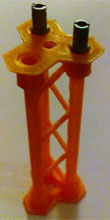Dimensions 3d Model Design and Printing Lab in Ogden, Utah |
| Develop, discover, create |
| Quickly and cost effectively go from a concept to a prototype. |
| Turn a drawing on a napkin into a solid model you can hold in your hand. |
3d printing technology is well suited for...
- Pneumatic Robotic applications
- Custom parts for remote control (RC) hobbiests
- Interlocking toy building block and brick designs
- Artistic sculpture
- Beam, truss, strut and attachment designs
- Matrix designs for higher strength
- Scalable designs
 View information on Services available from Dimensions Print Lab View information on Services available from Dimensions Print Lab
|
 |
|
3d printing options:
- Choose a material and color then print your 3d model
- Build custom Solidworks part and assembly files to detailed specifications
- Update and revise existing Solidworks part and assembly model files
- Convert Solidworks .sldprt model files into .stl Stereo Lithography files
- Convert .stl Stereo Lithography model files into Ultimaker 3 .gCode files
- Custom consultation and training for beginner and intermediate modelers
- Produce detailed engineering drawings for models
- Produce models that are part of larger assemblies
|
 |
|
3d printing plastic information: |
- Polylactic Acid (PLA)
A common plastic used for 3d printing is Polylactic Acid or simply PLA.
PLA is a plastic polymer that it is derived from renewable resources like corn starch or sugar cane.
Most plastics are derived from petroleum which is a non-renewable resource so PLA bioplastic provides some immediate advantages because it naturally degrades when exposed to the environment.
A PLA bottle left in the ocean would typically degrade in six to 24 months.
Utilizing existing manufacturing equipment designed for petroleum based products makes PLA relatively cost efficient to produce.
PLA is classified as a thermoplastic polyester because of the way the plastic responds to heat and becomes liquid at the melting point of 150-160 degrees Celsius for PLA.
Instead of burning, thermoplastics like PLA can be heated to their melting point, cooled, and reheated again without significant degradation which allows them to be easily injection molded and recycled.
PLA is non-toxic and may be used in food handling and medical implants. One disadvantage to PLA is its low melting point temperature between 111 and 145 °F and is therfore unsuitable for high temperature applications. Summer heat could cause parts to soften and deform.
Chemical Formula: C3H4O2
Melt Temperature: 157 to 170 °C (315 to 338 °F)
Typical Molding Temperature: 178 to 240 °C (353 to 464 °F)
Heat Deflection Temperature (HDT) : 49 to 52 °C (121 to 126 °F) at 0.46 MPa (66 PSI)
Tensile Strength: 61 to 66 MPa (8840 to 9500 PSI)
Flexural Strength: 48 - 110 MPa (6,950 to 16,000 PSI)
- Acrylonitrile Butadiene Styrene (ABS)
Another common plastic used for 3d printing is Acrylonitrile Butadiene Styrene or simply ABS. ABS is a thermoplastic and amorphous polymer that it is created by polymerizing styrene and acrylonitrile in the presence of polybutadiene. Thermoplastics become liquid at a specific temperature and can be heated to their melting point, cooled, and re-heated again without of burning.
ABS is classified as a thermoplastic because of the way the plastic responds to heat and becomes liquid at the melting point of 105 degrees Celsius (221 °F). Instead of burning, thermoplastics ABS can be heated to their melting point, cooled, and reheated again making them easy to recycle.
ABS is relatively cost efficient to produce, has a strong resistance to corrosive chemicals, is impact resistant and tough. There are no known carcinogens or adverse health effects related to ABS.
While ABS has a low melting point temperature, it will retain it's strength and shape even in hot summer heat and is usable can be used between -20 and 80 °C (-4 and 176 °F).
Chemical Formula: (C8H8~C4H6~C3H3N)n
Melt Temperature/ Glass Transition: 105 °C (221 °F)
Typical Molding Temperature: 204 to 238 °C (400 to 460 °F)
Heat Deflection Temperature (HDT): 98 °C (208 °F) at 0.46 MPa (66 PSI)
Tensile Strength: 46 MPa (6600 PSI)
Flexural Strength: 74 MPa (10800 PSI)
|
| Ultimaker 3 Extended Printer Specifications: |
Technology: Fused Filament Fabrication
Maximum build volume: 8.5 x 8.5 x 12.0 inches (215 x 215 x 305 mm) L / W / H
Maximum layer resolution: 20 micron (0.02 mm)
Print head travel speed: 30 mm/s to 350 mm/s
|
| 3d Print models quickly in .6mm draft resolution or high quality .2mm resolution. |
|
|
